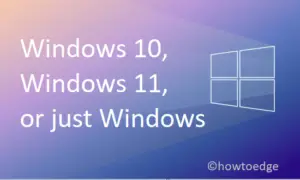In this blog post, we will illustrate the minimum System Requirements to Run Windows 11 on your computer. As we all know, Microsoft has really made surprised us with the sudden announcement of the Windows 11 operating system. The new OS is loaded with a lot of advanced changes and general usability improvements.

However, users willing to download and install Windows 11, must meet the minimum system requirements. If your device does not meet these requirements, you will not be able to install Windows 11 on your computer.
In such a case, you will have to buy a new computer that fulfills the required criteria to run Windows 11. So, let’s take a look at this.
Windows 11 System Requirements
The following description shows the minimum system requirements to run Windows 11 –
Of all these features, Windows 11 requires TPM 2.0 that is the most unexpected reason your PC might not meet the system requirements. This issue may appear if your computer running a slightly older Windows version. If you want to check your system’s TPM version, use the steps –
- Press the Win+R keys to open the Run dialog box.
- Type
tpm.mscin the text box and hit Enter.
What are the new system requirements to run Windows 11?
These are the new system requirements as laid down by Microsoft –
| Feature | Requirements |
| Processor | 1 GHz or faster with minimum 2 cores on a 64-bit processor or System on a Chip (SoC) |
| System firmware | UEFI, Secure Boot capable |
| Storage | 64 GB at least |
| RAM | 4 GB |
| TPM | TPM version 2.0 |
| Display Adapter | Supporting DirectX 12 or greater with WDDM 2.0 driver |
| Display | HD (720p) display that is greater than 9” diagonally, 8 bits per color channel |
| Client Hyper-V | Processor with SLAT capabilities |
| DirectX 12 Ultimate | Compatible games and graphics chips |
| 5G support | 5G supporting modem |
| Cortana | Microphone and speaker |
| DirectStorage | Minimum 1 TB NVMe SSD to save and run games that use the Standard NVM Express Controller driver and a DirectX 12 Ultimate GPU |
| BitLocker to Go | USB flash drive |
| Windows Hello | camera SET for near-infrared (IR) imaging or fingerprint reader for biometric authentication |
| Multiple Voice Assistant (MVA) | Speaker and microphone |
| Snap | 1920 effective pixels or greater in width |
| Internet connection and Microsoft accounts | Windows 11 Home requires access to the internet and a Microsoft account to perform device setup on first use. Similarly, Switching a device out of Windows 11 Home in S mode also requires internet access. See more about S mode here. For every Windows 11 edition, internet connectivity is required to compete for updates and to download and use some features. |
| Auto HDR | HDR monitor |
| Wake on Voice | Modern Standby power model and microphone |
| Wi-Fi 6E | WLAN IHV hardware and driver and a Wi-Fi 6E capable AP/router |
| Spatial Sound | Compatible hardware and software |
| Teams | Microphone, Video camera, and speaker |
| Intelligent Video Conferencing | Microphone, Video camera, and speaker |
| Windows Projection | Display adapter compatible with Windows Display Driver Model (WDDM) 2.0 and a Wi-Fi adapter that supports Wi-Fi Direct. |
Windows 10 vs Windows 11 System Requirements
| Windows | 11 | 10 |
| Internet Connection | Windows 11 Home requires an internet connection and a Microsoft account to set up the system on first use. |
1. It requires an internet connection to set it up for first use. 2. It does not require a Microsoft account. |
| RAM |
4 gigabyte (GB) |
1 gigabyte (GB) for 32-bit or 2 GB for 64-bit |
| Processor | Supports only 64-bit CPUs | Supports 32-bit and 64-bit CPUs |
| System Firmware and TPM | It requires UEFI, Secure Boot, or TPM but only if you use features such as BitLocker. | By default, it does not require UEFI, Secure Boot, or TPM. |
| Storage |
64 GB or larger storage device |
32-bit requires 16 GB and 64-bit requires 20 GB of storage |
| Display | Windows 11 requires 1280×720 or higher | It requires an 800×600 display |
| Graphics Card | Compatible with DirectX 12 or later with WDDM 2.0 driver |
DirectX 9 or later with WDDM 1.0 driver |
What are the processors that support Windows 11 installation?
As opposed to its previous processor’s requirements that support Intel core starting from 8th Gen, Microsoft now allows upgrading devices starting from 7th Gen Intel processors. However, the 7th Gen processor must be equipped with a 7820 HQ chip.
With the latest changes in the requirements, users on Intel’s Core X and Xeon W may also install the new operating system. Again, only when those devices come with Declarative, Componentized, Hardware Support Apps i.e. support for DCH drivers.
In case you are on AMD, Windows 11 will only support the second-generation Ryzen (including Threadripper) and newer processors. This also includes some EPYC and Athlon CPUs.
If you are on ARM support, the following processors support installing Windows 11 –
- Qualcomm Snapdragon 850, 7c, 8c, 8cx (1st or 2nd Gen)
- Microsoft SQ1 and SQ2
If your device still doesn’t meet the minimum system requirements, you may use Windows 11 ISO image to install it on your computer. However, proceed at your own risk as your PC might get damaged or start crashing every now and then.
Your system must possess the following features –
- 64-bit processor with at least two cores
- 4GB RAM
- 64 GB Storage
- TPM 1.2
Read Next:

